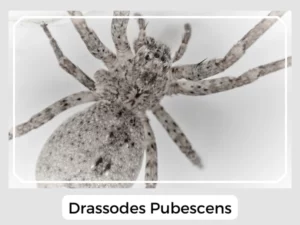The Drassodes spider is a type of ground spider. With 162 different kinds and even one special subspecies, they are an interesting bunch! Here, you’ll find cool facts about these spiders to help you understand them better.
The small, oval eggs remain within a thick-walled sac guarded by the females until they hatch.
Though an accurate description of the spiderlings remains unrecorded, like most other juveniles, they too get on their own within a month of hatching.
They do not make a web before capturing their prey. Instead, these spiders hunt down insects, and in the process, they might use some silk to entangle them.
Yes, Drassodes spiders have venom, but it’s primarily used to immobilize their small prey.
Yes, Drassodes spiders can bite if threatened or handled. However, their bite is usually not harmful to humans and may cause only minor discomfort.
Drassodes spiders play a crucial role in controlling the insect population in their habitats, acting as natural pest controllers. Their hunting behavior and nocturnal lifestyle help maintain a balance in the ecosystem, ensuring that insect populations do not become overwhelming.
Natural Predators and Prey-Predator Dynamics: Despite being predators themselves, Drassodes spiders are not without threats. Birds, larger spiders, and other predators feed on them, creating a complex prey-predator dynamic in their ecosystem. This dynamic ensures that the spider population is kept in check, contributing to the overall balance of their environment.
Relationship with Humans: Generally, Drassodes spiders are harmless to humans and prefer to keep to themselves. Their presence in gardens and outdoor spaces can be beneficial as they help control insect populations. However, it is crucial for people to be aware of them and handle them with care if necessary, to avoid any potential bites.
| Distribution | Kenya, South Africa, Indonesia, Russia, Afghanistan, India, and Ukraine |
| Habitat | Mostly in dry areas, under rocks, barks, and even leaves |
| Diet | Insects |
| Lifespan | 1 – 6 years |

In conclusion, Drassodes spiders are a fascinating and vital part of their ecosystem. Their unique hunting behavior, varied habitats, and ecological importance make them a species worth studying and understanding.
The Drassodes spider is a type of ground spider. With 162 different kinds and even one special subspecies, they are an interesting bunch! Here, you’ll find cool facts about these spiders to help you understand them better.
The small, oval eggs remain within a thick-walled sac guarded by the females until they hatch.
Though an accurate description of the spiderlings remains unrecorded, like most other juveniles, they too get on their own within a month of hatching.
They do not make a web before capturing their prey. Instead, these spiders hunt down insects, and in the process, they might use some silk to entangle them.
Yes, Drassodes spiders have venom, but it’s primarily used to immobilize their small prey.
Yes, Drassodes spiders can bite if threatened or handled. However, their bite is usually not harmful to humans and may cause only minor discomfort.
Drassodes spiders play a crucial role in controlling the insect population in their habitats, acting as natural pest controllers. Their hunting behavior and nocturnal lifestyle help maintain a balance in the ecosystem, ensuring that insect populations do not become overwhelming.
Natural Predators and Prey-Predator Dynamics: Despite being predators themselves, Drassodes spiders are not without threats. Birds, larger spiders, and other predators feed on them, creating a complex prey-predator dynamic in their ecosystem. This dynamic ensures that the spider population is kept in check, contributing to the overall balance of their environment.
Relationship with Humans: Generally, Drassodes spiders are harmless to humans and prefer to keep to themselves. Their presence in gardens and outdoor spaces can be beneficial as they help control insect populations. However, it is crucial for people to be aware of them and handle them with care if necessary, to avoid any potential bites.
| Distribution | Kenya, South Africa, Indonesia, Russia, Afghanistan, India, and Ukraine |
| Habitat | Mostly in dry areas, under rocks, barks, and even leaves |
| Diet | Insects |
| Lifespan | 1 – 6 years |

In conclusion, Drassodes spiders are a fascinating and vital part of their ecosystem. Their unique hunting behavior, varied habitats, and ecological importance make them a species worth studying and understanding.